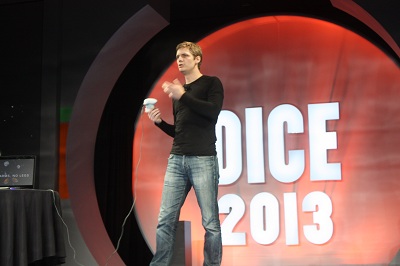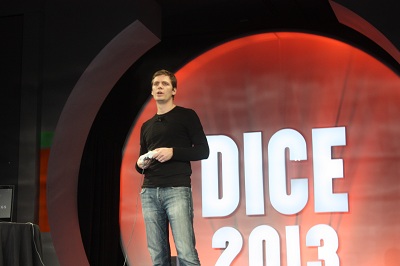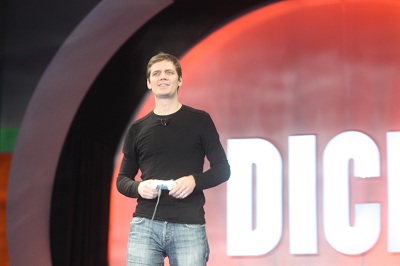GamesBeat: Is the learning very specific to Nintendo’s platform, or have you learned things that could be useful for games on all the platforms you work with?
Poix: Each new console is a new approach. What we learn can make it easier on the next console — we have a more clever approach when we start on design. In this case, I think it just reinforced what we strongly believe in. Influence is the way to convey emotion in gaming. For every console, we’ve done our job when we can turn innovation into emotion. That’s what we want to convey in our experience. We did that on the Wii, and we did it again with the Wii U.
Nintendo’s systems have brought something new each time. It was the motion controls first, and then it was the multiscreen approach. It’s funny. Sometimes you’ll turn the constraints of this innovation into something new. When we first prototyped on the Wii U, with the second screen … once again, you can’t playtest it so much. It’s a new Nintendo system that nobody knows anything about. You have to go on your intuition. On the team, there were people who were troubled by the fact that we were asking the player to look at the TV screen, come back to the GamePad screen, do something, and go back and forth like that all the time. It was a good point. We sat down to think about how we could push the limits of it — what could we convey? It can convey some stress because it’s hard to do something on the screen while still watching stuff up on the TV. That’s why we created a survival game.
It’s something that we learned on the Wii U about this particular approach, but it’s exactly in line with where the industry is going. We’ve had portable devices arriving for years, but today they can provide the same kind of image quality you can have on consoles. Today is a good time to leverage the HD art that we’ve developed in the past to make sure we have this quality on different devices, as long as we adapt to those devices in terms of gameplay.
 GamesBeat: I went to [the Consumer Electronics Show], and there were a lot of interesting technologies that could be useful for gaming there. I wonder what you guys might be excited about. 4K TVs were everywhere. They’re $10,000 dollars or more now, but it made me wonder … is it necessary? Is that something the industry has to go to?
GamesBeat: I went to [the Consumer Electronics Show], and there were a lot of interesting technologies that could be useful for gaming there. I wonder what you guys might be excited about. 4K TVs were everywhere. They’re $10,000 dollars or more now, but it made me wonder … is it necessary? Is that something the industry has to go to?
Poix: Obviously, innovation is something we’re really excited about at first. Seeing what will be adopted by the audience, what will last … it’s hard to tell. But innovation is what inspires us. Sometimes the technology inspires you, but with this inspiration you do something else. I can’t tell. With the Xbox, I’ve read some stuff about what they want to do with the Kinect. You can render some of the stuff in your living room on the TV? Doing that kind of augmented reality in your living room.
GamesBeat: Intel had what they called perceptual computing for laptops. They had eye tracking and facial recognition and voice recognition — like a gestural touch screen. They seem to want to deliver that in the next year. And then there were all these Android things. Nvidia’s Project Shield. There’s a lot of that kind of stuff happening on new platforms. It’s totally different from the consoles.
Poix: You’re right. Each platform has its new opportunities. New technologies bring us new business models, too, for games. We come from a business model where we create a whole long experience of gameplay where we can spend a few million dollars on it. The portable devices are bringing another model. Today, we’re trying to merge everything. We want to take the limitations between all these devices and make it into something more common, as far as how people play. Once again, though, it’s all opportunities to create new kinds of games.
GamesBeat: Ubisoft has a strategy of experimenting on all the new platforms and new consoles, right? How do you carry that into this new world, when you’re going to have so many different platforms?
Poix: We have a long history launching games on new platforms. Each time you have to think differently. It’s good for design innovation. But we can’t say which ones will succeed. I don’t think everything will succeed at a level that’s needed in order to invest all our efforts. But for sure, the period we’re living in is really interesting.
 GamesBeat: Have you made any decisions on that front, then? Do you feel like there’s a core to what Ubisoft will do, and then some experimentation, and then some places you just won’t go?
GamesBeat: Have you made any decisions on that front, then? Do you feel like there’s a core to what Ubisoft will do, and then some experimentation, and then some places you just won’t go?
Poix: I don’t think there’s anywhere we won’t go. What we’ll push is in line [with] what we’ve pushed from the start — building a good experience and having the opportunity to sell the experience to the vast majority of people. Gamers, non-gamers, casual players. Today, it’s not very clear which audience will support this technology or that one. But we have a large portfolio, and that’s good for us because we can adapt.
GamesBeat: So are you still upbeat about consoles? Are you still optimistic?
Poix: Yeah, definitely. We think there are still a lot of things to do in terms of interconnecting with other devices. It has to be brought somewhere, and today it’s consoles that can leverage that.
GamesBeat: You just picked up a new studio in Montreal from THQ?
Poix: Yeah, we’re very happy to have new people and new talent join, especially when we’re at the start of a new cycle. Every new cycle of the industry is a moment where you need to be strong, to have the best talent, to leverage what will be new about this cycle.
 GamesBeat: Ghost Recon is one of your big franchises. How is the outlook for that, given what’s happened in the last year with the launches and so on?
GamesBeat: Ghost Recon is one of your big franchises. How is the outlook for that, given what’s happened in the last year with the launches and so on?
Poix: We love the Ghost Recon brand. At the core is something that we’ve tried to do, from Advanced Warfighter to Future Soldier. We’re trying to turn it into something more in line with what the consumer wants today. It started as a very hardcore approach. We want to benefit from that and present something new on the shooter market, a shooter where everything is so closely based on the Special Forces. We think that differentiates us from the competition.
Coming back to the devices, we launched something interesting in terms of approaching the usage of different devices in our games. I’m not sure you’re familiar with it, but we’ve launched different applications for the game. One of them is based on one of the core features of the game, the customization of your weapons. We want the players to be able to carry his Ghost Recon around whenever and wherever he goes. We have this app where you can take the customization mode from the game and have it on your device. When you’re walking between home and school or something like that, you can customize your gun, and then it synchronizes. When you go back to the console, you have whatever you’ve put together there. We’ve learned a lot about this. The more committed the fans are, the more they want to stay in contact with the brand.
 GamesBeat: I guess Facebook turned out to be harder to figure out, though, since you closed Ghost Recon Commander.
GamesBeat: I guess Facebook turned out to be harder to figure out, though, since you closed Ghost Recon Commander.
Poix: Yes. Facebook is another challenge. We believe that, in the Facebook market … there are gamers who are also on Facebook and who play with the same brands they enjoy. There are new people, casual players, who at some point might turn towards more core games.
GamesBeat: Are there any other points you’d like to make?
Poix: Yeah, many more, but basically it’s just around this idea of creativity and innovation, how the two are mixing together. It’s a way of thinking about what we’ve done in the past. It’s funny. Once the consoles have launched, everybody thinks it’s obvious what you should have done. When you’ve lived through this evolution of technology, though, and designing a game in the middle of it, it brings a lot of experience in terms of what you can design under those constraints.
You mentioned Ghost Recon. At the launch of the Xbox 360, we’d really expanded Ghost Recon’s design with the new technology. We had new graphics, with the shaders and everything else on the 360. But more than that, we were able to do everything we’d wanted to with design in the past. We were following the same pillars of the brand — Special Forces and that kind of thing — but we could render larger maps with beautiful graphics. We could convey more emotion to the player. We wanted to bring it into the modern day with new weapons and new tools. We wanted the player to switch from one point of view to the other, one teammate to the other, or from a teammate to a withdrawn point of view, which could be very high in the sky. All the while, we could have the same quality of graphics. That’s what new technology did for us.
VentureBeat's mission is to be a digital town square for technical decision-makers to gain knowledge about transformative enterprise technology and transact. Learn More
